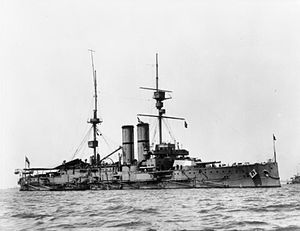 HMS Hibernia c. 1914–1918
| |
| History | |
|---|---|
| Name | HMS Hibernia |
| Namesake | Hibernia, the Roman name for Ireland |
| Builder | Devonport Dockyard |
| Laid down | 6 January 1904 |
| Launched | 17 June 1905 |
| Completed | December 1906 |
| Commissioned | 2 January 1907 |
| Decommissioned | October 1917 |
| Fate | Sold for scrapping 8 November 1921 |
| General characteristics | |
| Class and type | King Edward VII-class pre-dreadnought battleship |
| Displacement | |
| Length | 453 ft 9 in (138.3 m) (loa) |
| Beam | 75 ft (22.9 m) |
| Draught | 25 ft 8 in (7.82 m) |
| Installed power |
|
| Propulsion | |
| Speed | 18.5 knots (34.3 km/h; 21.3 mph) |
| Complement | 777 |
| Armament |
|
| Armour | |
HMS Hibernia was a King Edward VII-class pre-dreadnought battleship of Britain's Royal Navy. Like all ships of the class (apart from HMS King Edward VII) she was named after an important part of the British Empire, namely Ireland. The ship was built by Devonport Dockyard; she was laid down in January 1904, was launched in June 1905, and was completed in December 1906. Armed with a battery of four 12-inch (305 mm) and four 9.2 in (234 mm) guns, she and her sister ships marked a significant advance in offensive power compared to earlier British battleship designs that did not carry the 9.2 in guns.
Commissioned in early 1907, Hibernia served as the flagship of the Rear Admirals of firstly the Atlantic Fleet and then the Channel Fleet. When the latter fleet was reorganised to the Home Fleet, she was based at the Nore. In 1912, Hibernia hosted trials in naval aviation with the temporary addition of a runway to her foredeck, and the first launch of an aircraft from a vessel underway was achieved from her in early May. Later in 1912, after her experiment with aviation was completed, she and her sister ships formed the 3rd Battle Squadron. That year, the squadron went to the Mediterranean Sea during the First Balkan War as part of an international blockade of Montenegro. In 1913, the ship returned to British waters.
The squadron was assigned to the Grand Fleet at the beginning of the First World War, and served on the Northern Patrol. Through 1914 and 1915, the ships frequently went to sea to search for German vessels, but Hibernia saw no action during this period. By the end of the year, the Grand Fleet stopped operating with the older 3rd Battle Squadron ships, and in December 1915, Hibernia was transferred to the Gallipoli Campaign and provided cover for the evacuation from the Gallipoli Peninsula. On returning to the United Kingdom she was again attached to the Grand Fleet before being transferred to Nore Command in May 1916, finishing the war as an accommodation ship. She was decommissioned in 1919 and scrapped in 1922.